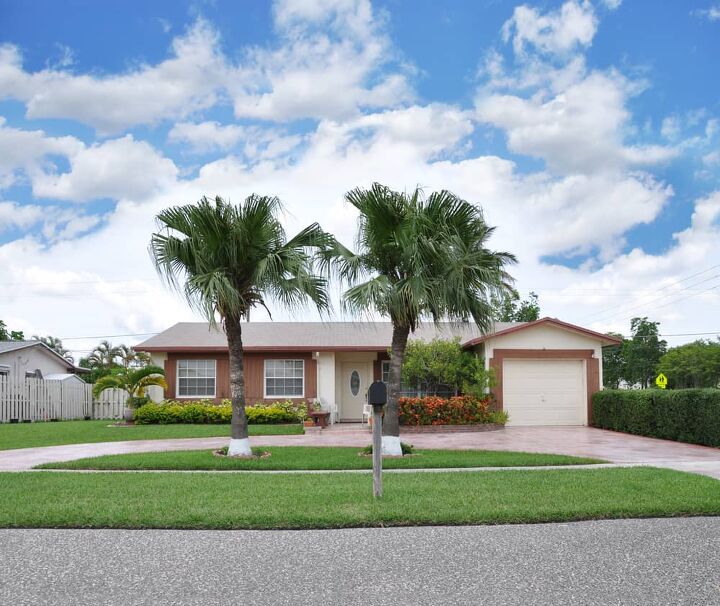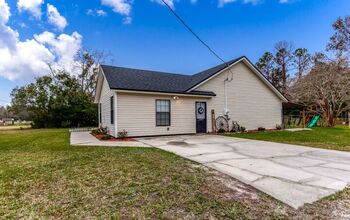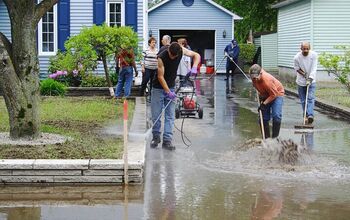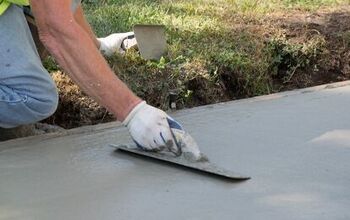Residential Circular Driveway Dimensions (with Photos)

A circular driveway can be an exciting feature to add to your home. Circular driveways offer more space to park and give drivers an option besides backing into the street. They usually fit best on larger properties because there needs to be ample front yard space.
A circular driveway should be around 10 feet wide and about 12-14 feet deep. However, they can also be laid out differently for larger cars, vans, and RVs. Though, specific dimensions for circular driveways can vary from state to state based on regulations.
Do You Need a Brick and Stone Floor Contractor?
Get free, zero-commitment quotes from pro contractors near you.

Determining the Dimensions of Your Circular Driveway
If you already have a circular driveway, it’s possible to calculate the square footage of it with some math. If you purchased a house without a paved circular driveway, knowing square footage can help you pave it. This can ensure that you purchase the correct amount of materials for the project.
Some circular driveways are a complete circle with a straight driveway connecting to the street. More popular, however, are circular driveways that are actually semi-circles. The flat ends of the semi-circular driveway connect to the road.
To calculate the square footage of your circular driveway, you will need the following materials:
- A tape measure
- An 8 to 10-foot long straightedge
- A marker
- A calculator
Making A Circular Driveway Wider
How to Measure the Square Footage of Your Circular Driveway
Step One: Using a straightedge, draw a line through the center and to the outer edges of the circle. You can find the center by measuring from one outside edge to the other outside edge at the widest point.
Step Two: Using the tape measure, measure the line you drew through the center. This is the diameter of the circle.
Step Three: Divide the diameter by two. This will give the radius of the circular driveway.
Step Four: If your driveway is circular and not semi-circular, use the area formula for a circle next. Take your radius measurement, square it, and multiply it by pi (3.14159).
Step Five: Repeat steps one through four with the piece of land in the center of your driveway. This is usually an area you cannot drive on. It is sometimes made into a green space or a site for a fountain.
Step Six: Subtract the area of the smaller circle from that of the larger circle. This will give you the area of the driveable portion of the driveway.
Step Seven: To find the square footage of your driveway, divide this number by 12. This takes the area of the driveway from inches to feet.
How to Calculate the Size of Your Semicircular Driveway
To calculate your semicircular driveway area, you can use the same materials needed to find the area of a circular driveway. Follow these steps to find the area:
Step One: Using the straightedge, mark a line from the widest edge of the semi-circle to its other edge. Mark through the center. This will most likely be where the ends of the driveway meet the street.
Step Two: Measure the line you’ve just drawn. This is the diameter.
Step Three: Divide the diameter by two. This will give you the radius of the semi-circle.
Step Four: Take the radius and square it. Divide this number by two and multiply by pi. This will give you the area of the entire semi-circle.
Step Five: Repeat steps one through four with the semi-circular area inside the semicircular drive. This is the area that people can’t drive on and is likely lawn space.
Step Six: Subtract the number found in step five from the number found in step four. This will give you the driveable area of the semicircular driveway.
Step Seven: Convert this number from inches to feet by dividing it by 12. This will provide you with the square footage of the driveway.
Circular Driveway Codes
Different states have different codes for circular driveway dimensions.
For example, in St. Petersburg, Florida, the circular part of the driveway should be between 10 and 14 feet wide. The driveway can be no more than 20 feet wide where it meets the curb. It is also not permitted to have a circular driveway on a lot less than 60 feet wide.
If you are looking to install a circular driveway in your yard, check your local codes. These codes will help ensure your circular driveway is the correct size. It will also prevent you from getting in trouble with the local government for accidentally breaking the rules.
Consider Vehicle Turning Paths When Planning a Circular Driveway
It is essential to consider your vehicle’s turning radius when thinking about adding a circular driveway. Your car’s turning radius is the smallest turn it can make. You can measure it by finding the radius of the car’s outer wheels while making a turn.
The average turning radius of a car is around 35 feet. The smaller the turn radius, the tighter the turn a car can make.
If your circular driveway is too tight of a circle, not all cars will be able to turn in it. Your driveway will need more clearance for larger cars.
Extra Considerations for a Circular Driveway
Circle driveways can be an optimal driveway for large cars. This type of driveway is an excellent option for drivers who hate backing up. It allows you to simply pull through your driveway rather than back into the street.
If you have a circular driveway with a wide enough turning radius, you can store large vehicles. RVs and trailers are a perfect fit in circular driveways.
You can store one of these in a circular driveway to make it easier to leave. With a circular driveway, you don’t have to worry about backing something so large in and out of it.
How Well Do RVs Fit in a Circular Driveway?
RVs can vary in their largeness. Most RVs are between 10 and 14 feet tall and around 8 ½ feet wide. They can be anywhere from 25 to 40 feet long. A sizable circular driveway can help you store your RV with ease. However, make sure to check your local codes to see how big is too big for a circular drive.
Also, check to see if you can store an RV in your driveway at all. Plus, keeping an RV in your driveway will force other cars to back out of the driveway.
A travel trailer is a bit smaller than an RV, usually around 30 feet in length. They are usually about 8 feet wide.
The length of travel trailers you can have varies from state to state. For example, Alabama only allows travel trailers to be 28 feet 6 inches long. Florida, on the other hand, allows 48-foot travel trailers.
However, despite the fact that travel trailers are smaller than RVs, they will still block your circular driveway. Most circular driveways are around 10 feet wide. An 8-foot wide travel trailer will prevent other cars from using the circular driveway to its fullest extent.
Do You Need a Brick and Stone Floor Contractor?
Get free, zero-commitment quotes from pro contractors near you.

Related Questions
What is the cost of a circular driveway?
The cost of a driveway varies based on material and square footage. Once you know the square footage of your driveway, you can determine the cost of materials. Generally, circular driveways tend to be more expensive than straight driveways because they will take up more space. The average cost per square foot of a concrete driveway is around $6.70. Asphalt is a bit cheaper, between $3.50 and $4.50 per square foot. Gravel is the most affordable, between .50 and $2 per square foot. If you’d like a paved or bricked driveway, this will cost you $10 to $50 per square foot. The slopes and curves of a circular driveway will increase the cost of your driveway, no matter the material.
How is a circular driveway different from a turnaround driveway?
A circular driveway is technically a type of turnaround driveway. Turnaround driveways provide you with a way out onto the street that doesn’t require backing up. You can really design these types of driveways any way you want. However, make sure you check your local codes to make sure you aren’t breaking any rules.There are circular, teardrop, and freeform turnaround driveways. Of course, circular driveways usually appear as half-circles. Two ends of the half-circle provide you with access to the street.The teardrop turnaround driveway provides you with only one way of accessing the street. However, it does not require any backing up. The teardrop shape creates a cul de sac type of driveway. This makes it easy to turn and exit back onto the street. The freeform driveway doesn’t have a set shape. This type allows you to pull up to your garage or pull forward toward the street. The freeform turnaround driveway makes a great driveway for the storage of large vehicles. You can keep RVs or travel trailers by the garage and still leave space for other cars to maneuver.
Related Guides

Stacy Randall is a wife, mother, and freelance writer from NOLA that has always had a love for DIY projects, home organization, and making spaces beautiful. Together with her husband, she has been spending the last several years lovingly renovating her grandparent's former home, making it their own and learning a lot about life along the way.
More by Stacy Randall





















![How To Reset A Whirlpool Cabrio Washer [In 5 Easy Steps!]](https://cdn-fastly.upgradedhome.com/media/2023/07/31/9076531/how-to-reset-a-whirlpool-cabrio-washer-in-5-easy-steps.jpg?size=350x220)











